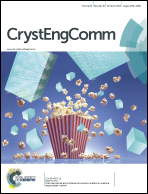Assembly of Co(ii)/Cu(ii)–azido polynuclear polymers: structural diversity and magnetic behavior†
Abstract
Hydrothermal reaction of cyano-substituted viologen derivatives and NaN3 with corresponding metal salts in the presence/absence of H2PTA (H2PTA = p-phthalic acid) yielded three azide-based polynuclear coordination polymers: [Co4(N3)4(PTA)3(4-CV)2]n·2nH2O 3D (1), [Co4(N3)4(PTA)3(3-CV)2]n·nH2O 3D (2), and [Cu6(N3)14(4-CV)2]n 2D (3) (3/4-CV+ = 4,4′-bipyridinium-N-methyl-3/4-benzonitrile). The azido bridges are employed to construct two types of polynuclear cluster units: tetranuclear [Co4(μ1,1-N3)4] and hexanuclear [Cu6(μ1,1-N3)6(μ1,1,1-N3)4]. Polymers 1 and 2 are isostructural, and exhibit similar 3D frameworks constructed by unprecedented linear tetranuclear CoII4 units with a four-connected 65·8 topology. Polymer 3 features a 2D (4,4) topological network built up by hexanuclear CuII6 segments. The azide anion exhibits diverse coordination modes: μ1,1-N3 in 1 and 2, and μ1,1-, μ1,3-, μ1,1,1- and μ1,1,3-N3 in 3. Variable-temperature magnetic susceptibility data denote that 1 and 2 display a weak antiferromagnetic interaction in CoII4 units and 3 shows a dominant ferromagnetic exchange in CuII6 units.


 Please wait while we load your content...
Please wait while we load your content...